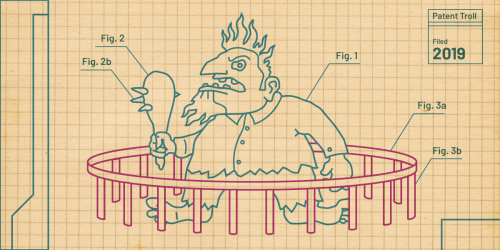This month’s stupid patent describes an invention that will be familiar to many readers: a virtual reality (VR) system where participants can interact with a virtual world and each other. US Patent No. 6,409,599 is titled “Interactive virtual reality performance theater entertainment system.” Does the ’599 patent belong to the true inventors of VR? No. The patent itself acknowledges that VR already existed when the application was filed in mid-1999. Rather, it claims minor tweaks to existing VR systems such as having participants see pre-recorded videos. In our view, these tweaks were not new when the patent application was filed. Even if they were, minor additions to existing technology should not be enough for a patent.
The ’599 patent is owned by a company called Virtual Immersion Technologies, LLC. This company appears to have no other business except patent assertion. So far, it has filed 21 patent lawsuits, targeting a variety of companies ranging from small VR startups to large defense companies. It has brought infringement claims against VR porn, social VR systems, and VR laboratories.
Virtual reality was not new in mid-1999. The only supposedly new features of the ’599 patent are providing a live or prerecorded video of a live performer and enabling audio communication between the performer and a participant. Similar technology was infamously predicted in the Star Wars Holiday Special of 1978. In this sense, the patent is reminiscent of patents that take the form: “X, but on the Internet.” Here, the patent essentially claims video teleconferencing, but in virtual reality.
Claim 1 of the ’599 patent is almost 200 words long, but is packed with the kind of mundane details and faux-complexity typical of software patents. For example, the claim runs through various “input devices” and “output devices” assigned to the “performer” and “participant.” But any VR system connecting two people will have such things. How else are the users supposed to communicate? Telepathy?

Like many software patents, the ’599 patent describes the “invention” at an absurdly high, and unhelpful, level of abstraction. Any specific language in the patent is hedged to the point that it becomes meaningless. The “input devices” might be things like a “keypad or cyberglove,” but can also be any device that “communicate[s] with the computer through a variety of hardware and software means.” In other words, the “input device” can be almost any device at all. The patent suggests that the “underlying control programs and device drivers” can be written in “in many different types of programming languages.” Similarly, the “network communication functions” can be accomplished by any “protocols or means which may currently exist or exist in the future.” The overall message: build yourself a VR system from scratch and risk infringing.
RPX filed an inter partes review petition arguing that claims of the ’599 patent were obvious at the time of the application. The petition argues, persuasively in our view, that earlier publications describe the supposed invention claimed by the ’599 patent. The inter partes review proceeding has since settled, but any defendant sued by Virtual Immersion Technologies, LLC can raise the same prior art (and more) in their defense. Unfortunately, it is very expensive to defend a patent suit and this means defendants are pressured to settle even when the case is weak.
The ’599 patent highlights many of the weaknesses of the patent system, especially with respect to software patents. First, the Patent Office failed to find prior art. Second, the patent claims are vague and the patent isn’t tied to any concrete implementation. Finally, the patent ended being used to sue real companies that employ people and make things.







